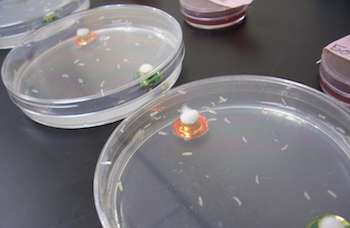How the larvae of fruit flies responded to the odor of fruit, indicating a food source, by itself or combined with an electric shock helped a team of researchers led by a Rice University professor to link the effects of nature and nurture in changing the behavior of a population. Credit: Saltz Lab
You live, you learn—even if you're a larva and especially if there's a little shock involved.
That doesn't sound particularly nurturing, but the jolt was important to a Rice University scientist and her team who studied common fruit fly larvae. Their strategy helped them conclude that nature and nurture do collaborate in determining the behavior of a population.
Rice evolutionary biologist Julia Saltz and her colleagues studied the habits of about 50,000 Drosophila melanogaster larvae that, like people, have the ability to sense enticing odors and an incentive to avoid them when they're associated with an unpleasant experience.
The researchers found that some genotypes with particular hereditary variations use these environmental pain-and-pleasure cues to make better decisions about where to pupate.
The study appears this month in The American Naturalist.
"The old opposition between nature and nurture presents behaviors as either due to genes or to learning—but not both," said Saltz, a Rice assistant professor of ecology and evolutionary biology. "In contrast, genetic differences might influence the ways that individuals interact with and learn from their environments."
The researchers looked at two types of behavioral plasticity – contextual and developmental – to see how they combined to train larvae that were first attracted to a fruit-like odor that hinted at a source of food and then given a shock that taught many of them to avoid it. The researchers measured different fly genotypes from a single population and found heritable genetic variation in the flies' ability to associate an odor with a harmful electric shock.
Over more than 800 trials, Saltz and her team trained larvae to recognize the fruity odor of ethyl acetate on a disk of filter paper placed on one side of a petri dish. A neutral disk with paraffin oil was placed on the other side. Larvae were then "trained" to associate the odor with a mild shock in a second dish, and judged on how well they learned to avoid the odor after either five minutes or three hours.
The results showed no differences between initial learning and three-hour memory, simplifying the task of judging the larvae's performance due to genetic differences.
Finally, the researchers judged their subjects' "pupation plasticity" in another 364 trials, putting wandering larvae close to pupation in dishes with bottoms that either had fruit juice or not and clean covers to which they could escape.
The effect was modest, as separate experiments showed about 70 percent of larvae pupated on the plain substrate and only 50 percent on the juice-infused surface, but it was enough to suggest that learning differences seen between genotypes in the shock tests correlated positively with genetic variation in pupation plasticity.
"Genotypes that are more adept at learning to avoid the odor also use environmental cues to fine-tune their decisions about where to pupate, more so than genotypes with lower learning scores," she said. "These results represent the first time these two seemingly different types of behavioral changes have been found to be genetically correlated."
Identifying the relationships between learning and other types of behavioral flexibility helps researchers predict how animals might alter their behavior in response to environmental changes, such as the appearance of an invasive species, and for understanding how learning might evolve, Saltz said.
"More broadly, genetic variation in the ways that individuals interact with and respond to their environments highlights the complex ways that both genes and the environment—nature and nurture—together orchestrate behavior," she said.
More information: Julia B. Saltz et al. Genetic Correlations among Developmental and Contextual Behavioral Plasticity in, The American Naturalist (2017). DOI: 10.1086/692010
Journal information: American Naturalist
Provided by Rice University
























